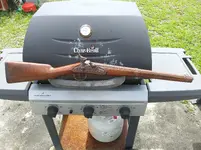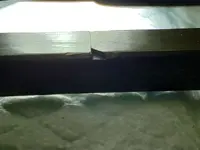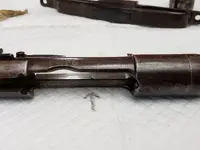Bigcypresshunter
Sapphire Member
- Joined
- Dec 15, 2004
- Messages
- 27,000
- Reaction score
- 3,340
- Golden Thread
- 0
- Location
- South Florida
- Detector(s) used
- 70's Whites TM Amphibian, HH Pulse, Ace 250
- Primary Interest:
- Beach & Shallow Water Hunting
I have what looks like an authentic antique 12 gauge muzzleloading shotgun with a heavy duty sidelock and musket cap nipple. It says 1850 OBERNDORF on the barrel and something else on the sidelock. This shotgun is heavy duty and would hold up well if abused. It has a short smoothbore barrel and a horse ring attachment. This gun looks as if it did its killing at short range.
It may be a Mauser but I cant find it in search and I cant read the sidelock. Looks like 3 words. The second word starts with a W. The third word looks like RABBIT but first letter looks more like an F like maybe FABRIK??
![20190630_015714[1].webp 20190630_015714[1].webp](https://www.treasurenet.com/data/attachments/1550/1550857-edf7c192846fa9d20488ff875c967915.jpg?hash=Pjrb1ta1lm)
![20190630_015459[2].webp 20190630_015459[2].webp](https://www.treasurenet.com/data/attachments/1550/1550884-0dac1a12722ccbe468dba7a64d413dd9.jpg?hash=Nk2wgYgDvL)
![20190630_015613[2].webp 20190630_015613[2].webp](https://www.treasurenet.com/data/attachments/1550/1550906-a662c4badac94c0cad4311a1d5d5d831.jpg?hash=Wguk8tQp_Z)

Added: It may be Confederate Cavalry Carbine!
It may be a Mauser but I cant find it in search and I cant read the sidelock. Looks like 3 words. The second word starts with a W. The third word looks like RABBIT but first letter looks more like an F like maybe FABRIK??
![20190630_015714[1].webp 20190630_015714[1].webp](https://www.treasurenet.com/data/attachments/1550/1550857-edf7c192846fa9d20488ff875c967915.jpg?hash=Pjrb1ta1lm)
![20190630_015459[2].webp 20190630_015459[2].webp](https://www.treasurenet.com/data/attachments/1550/1550884-0dac1a12722ccbe468dba7a64d413dd9.jpg?hash=Nk2wgYgDvL)
![20190630_015613[2].webp 20190630_015613[2].webp](https://www.treasurenet.com/data/attachments/1550/1550906-a662c4badac94c0cad4311a1d5d5d831.jpg?hash=Wguk8tQp_Z)

Added: It may be Confederate Cavalry Carbine!
Amazon Forum Fav 👍
Last edited:







